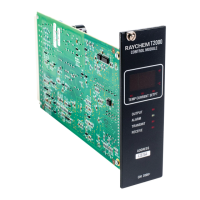10 | nVent.com
Ground Fault Alarm and Trip
Ground Fault (GF) current levels are monitored and may be displayed in mA. The availability of
the actual ground fault level gives the user the choice of both alarm and trip levels suitable for
the particular installation.
Overcurrent Protection
A unique overcurrent protection algorithm greatly reduces the possibility of damage to the
heating circuit or the SSR in the event of a temporary overload while allowing for initially high
in-rush currents (SSR options only).
Soft Starting
Given the circuit breaker size, the control module will limit the energy let-through to help
prevent nuisance breaker trips due to cable in-rush. This feature makes the control module
particularly attractive for use with self-regulating cables (SSR options only).
Minimum/Maximum Temperature Tracking
The control module maintains the minimum and maximum temperature values it has
measured since the last reset of these values. This is helpful in determining causes of
temperature alarms.
Latching/Non-latching Temperature Alarms
User selectable non-latching temperature alarms allow the control module to automatically
clear the alarm when the condition no longer exists.
High and Low Voltage Alarms
Operating at voltages less than design can cause serious loss of heater output. The alarming
of preset voltage deviations ensures the availability of sufficient wattage output.
Power-Limiting
The control module will control the maximum output wattage if the full load power exceeds
the specified Maximum Power Setpoint. This feature eliminates the need for low voltage
transformers in many applications and can assist in standardization of heating cable types
(SSR options only).
Auto-cycling
The control module will momentarily energize its heating circuit (for 10 seconds) at a
programmable interval. Heating circuit alarms will be generated at the time of auto-cycle
instead of when the heat is required. This feature eliminates the need for a preventative
maintenance program as these tests are performed at regular intervals by the control module.
Temperature Sensor Failure Alarm
Both open and shorted sensors are detected and alarmed by the control module. Additionally, the
control module may be configured to default to a remaining “good” sensor or to turn the output off.
Random Start
A startup delay between 0 and 9 seconds ensures that all control modules do not come on line
at the same time following a power failure.
Full Digital Communications
All control modules can communicate alarm and analog data to a monitoring system via the
alarm/communications interface card. With the availability of the heat trace data at the user’s
fingertips, historical trending of temperatures, power consumption, or other parameters are
available for analysis and system optimization.
CSA (C/US) & FM Approved
The RAYCHEM T2000 system is approved and certified for use in Class 1, Division 2, Groups
A,B,C,D hazardous locations, making them ideal for direct installation in the field. This can save
the expense of wiring back to a centrally located electrical distribution center.
Compact Size Modules
Innovative modular packaging allows for field addition of control modules as heating circuits
are added. Individual heating circuits can easily be locked out or replaced without affecting
other heating circuits. All heating circuits can be monitored simultaneously without scrolling.
Universal Voltage Input
The control module’s wide voltage input range (90 to 240 VAC) gives the user maximum
flexibility for installation and configuration as well as reducing the inventory requirements.

